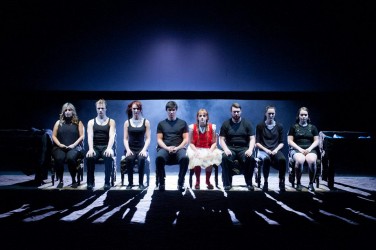Lion In The Streets
By Judith Thompson
Directed by Conrad Alexandrowicz
Phoenix Theatre, University of Victoria
February 12-21, 2015
Reviewed by Madeline McParland
Celebrated Canadian playwright Judith Thompson’s Lion In The Streets premiered 25 years ago to immediate acclaim. Set in an ethnic Toronto neighbourhood, the play is a series of interconnected stories that explores the complexities of human nature and exposes indecent behaviors that are often ignored. Director and choreographer Conrad Alexandrowicz has brought his interpretation of Lion In The Streets to life with UVic theatre students, in one of the most ambitious productions I have seen staged at Phoenix Theatre.
Isobel (played by Lindsay Curl) is the play’s central protagonist. The lost Portuguese girl is always present on stage, sometimes as the focus and sometimes as part of the audience, watching the troubled lives of her neighbours unfold. The first half of the play examines class issues and suburban life in Canada. Some intense moments dealt with marital infidelity, but the play also touched on humourous idiosyncrasies of contemporary life, such as Zoë Wessler’s portrayal of a mother, named Laura, who had everyone laughing at her shrill scream of “Bullshit!” when she interrogated a teacher about her child’s sugar intake at daycare. Multiple storylines made the plot difficult to follow at times, but dynamic acting compelled me to stop asking questions. Instead, I was caught in each powerful moment.
At first, I thought it peculiar most actors were present on stage, whether they were involved in the scene or not. They sat upstage and stood from time to time to rearrange chairs to fit the scene. Few props were used beside the chairs; instead the actors relied on intense physicality, acting as props or performing stunts. Actors not starring in the scenes, dressed in black, flitted around the main characters, sometimes to assist in spinning the characters in the air to emulate happiness. Other times, they would act as barriers to signify when a character felt emotionally trapped. Eventually, I decided this was a beautifully intriguing aspect of the play, and I recognized this perhaps as a trait of Alexandrowicz’s, an Associate Prof. at the University of Victoria, who is also artistic director of Vancouver company Wild Excursions Performance.
The humour came to a devastating halt in the second half of the play, when heavy social issues were explored deeply. Starting with Arielle Permack’s impressively strong portrayal of a woman with cerebral palsy, each scene hit harder than the last, dealing with emotionally charged issues such as gender, marital abuse, child abuse and death.
I was unsure how the stories would tie together in the end, yet I came to realize this play was truly about surrendering assumptions about storytelling. As the young girl Isobel watched these individuals’ experiences from beyond, just as the audience did, it became less about the mystery of her presence, and more about the reality of the convoluted, and disturbing, moments life can bring us.
Madeline McParland is a UVic student and freelancer.

{ 0 comments… add one now }